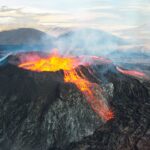
The extent of the multi-year ice in 2012. Credit: NASA/Goddard Scientific Visualization Studio
NASA scientists reveal that the oldest, thickest sea ice is disappearing at a faster rate than the younger and thinner ice.
Thicker ice, known as multi-year ice, survives through the summer melt season, while the younger, thinner ice that forms at the edges of the Arctic ice cap during winter melts again. However, the multi-year ice is now disappearing at a faster rate than the younger ice, according to a new study fromNASA.
The study, published in the Journal of Climate, has found the multi-year ice extent was found to be diminishing at a rate of -15.1 percent per decade. This rapid disappearance of older ice makes Arctic sea ice even more vulnerable to further decline in the summer, according to senior NASA scientist Joey Comiso.
Comiso also found that the multi-year ice area is shrinking even faster, by -17.2 percent per decade. “The average thickness of the Arctic sea ice cover is declining because it is rapidly losing its thick component, the multi-year ice,” he said.
“At the same time, the surface temperature in the Arctic is going up, which results in a shorter ice-forming season. It would take a persistent cold spell for most multi-year sea ice and other ice types to grow thick enough in the winter to survive the summer melt season and reverse the trend.”
The multi year ice reached its record minimum extent in 2008, when it was reduced to 55 percent of its average extent since 1970, when satellite measurements of the ice cap commenced. It then recovered for three years, but dipped again in 2012.
It is also shrinking faster than the perennial ice, defined as ice that has survived at least one summer. Perennial ice was found to be shrinking at a rate of -12.2 percent per decade, while its area is declining at a rate of -13.5 percent per decade.
The perennial ice retreat opened up new areas of the Arctic Ocean that could be covered by seasonal ice in the winter. The larger volume of younger ice meant a larger portion of it could survive the summer and form second year ice.
This is likely the reason why the perennial ice cover, which includes second year ice, is not declining as rapidly as the multiyear ice cover, Comiso said.
– Laura Boness
Source: NASA







